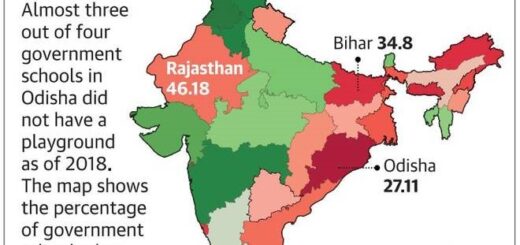National Current Affairs – UPSC/IAS Exams- 13th August 2019
Pradhan Mantri Jan Arogya Yojana (PM-JAY)
Topic: Government schemes
In News: Cancer treatments will soon be covered under the Ayushman Bharat Yojana- Pradhan Mantri Jan Arogya Yojana (PM-JAY).
More on the Topic:
- Ayushman Bharat – Pradhan Mantri Jan Arogya Yojana (AB-PMJAY) is a Centrally Sponsored Scheme having central sector component under Ayushman Bharat Mission anchored in the Ministry of Health and Family Welfare (MoHFW).
- PMJAY is government-sponsored health insurance scheme, that will provide free coverage of up to Rs 5 lakh per family per year in any government or empanelled private hospitals all over India.
- It will cover beneficiaries families identified on the basis of Socio Economic Caste Survey (SECC) 2011 in 444 districts of 30 states/Union Territories.
- National Health Agency (NHA) is the apex body for implementing this scheme.
- Around 13000 hospitals both public and private in the country have been coordinated for implementation of the scheme.
- PMJAY will be funded with 60% contribution from Centre and remaining from the states.
- NITI Aayog will be working as partner for this scheme for operationalizing robust, modular and interoperable IT platform which will involve a paperless and cashless transaction.
- PMJAY is entitlement based scheme with entitlement decided on basis of deprivation criteria in the SECC database. There will be no cap on family size and age under this scheme.
- The benefit cover under it also includes pre and post-hospitalisation expenses. It also takes into consideration all pre-existing medical conditions.
- States and UTs have flexibility to modify these rates within limited bandwidth.
- PMJAY allows national portabilitye. resident of any part of country is entitled for free hospitalization at empanelled hospital anywhere in the country.
- It will strengthen healthcare services in India by targeting poor and vulnerable population of the country.
- Beneficiaries will QR codes having letters for verification through scanning.
- Scheme also seeks to accelerate India’s progress towards the achievement of Universal Health Coverage (UHC) and Sustainable Development Goal – 3 (SDG3).
Source: The Hindu
Kajin Sara Lake
Topic: Environment and Ecology
In News: Newly discovered Kajin Sara lake in Nepal is likely to set a new record of being the world’s highest lake.
More on the Topic:
- The lake was discovered about a few months ago by a team of mountaineers.
- As per the measurement of the lake taken by the team, it is located at an altitude of 5,200 metres, which is yet to be officially verified. It is estimated to be 1,500-metre-long and 600-metre-wide.
- Currently Tilicho Lake holds the title of the world’s highest lake. It is situated at an altitude of 4,919 metres in Nepal.
Source: The Hindu
Krishna Wildlife Sanctuary
Topic: Environment and Ecology
In News: Recently, the Forest Department identified around 300 hectares of revenue land for inclusion in the Krishna Wildlife Sanctuary (KWS).
More on the Topic:
- The land is being diverted as compensation, for setting up a new Missile Test Launch Facility by the Defence Research and Development Organisation (DRDO)
- The move has also been recommended by the National Board for Wildlife.
About Krishna Wildlife Sanctuary:
- Krishna Wildlife Sanctuary is located in Andhra Pradesh, India.
- The sanctuary is a part of the mangrove wetland in Andhra Pradesh and is located in the coastal plain of Krishna delta, spread across Krishna and Guntur districts of Andhra Pradesh.
- The estuary of the Krishna River passes through the sanctuary.
- It is believed that this region potentially holds one of the most significant populations of fishing cats in the world.
- The fishing cat (Prionailurus viverrinus) is a medium-sized wild cat of South and Southeast Asia.
- Fishing cat populations are threatened by the destruction of wetlands and have declined severely over the last decade.
- The fishing cat is listed as Endangered on the IUCN Red List.
Source: The Hindu and Wikipedia
City Knowledge and Innovation Clusters
Topic: Government Policies
In News: Bhubaneswar, Chandigarh, Jodhpur, Pune, Ahmedabad and Hyderabad will be development as City Knowledge and Innovation Clusters.
More on the Topic:
- The project is led by the office of the Principal Scientific Advisor (PSA) on a priority basis.
- These clusters will provide a connect between the existing research and knowledge setups at institutions and various industries that exist in the city or state.
- A huge amount of knowledge and fiscal resources exist within a city or region. If these independent entities connect through a virtual platform, optimisation of resources can be achieved and various sectors will be able to work in partnership.
- The project will assist industries in gaining access to existing technology, and help academic institutions and R&D facilities commercialise this technology.
- Under the project each city cluster will be have a nodal office headed by a Chief Executive Officer (CEO), who will be selected by the stakeholders. Government officials, such as municipal commissioners, will also be a part of the city cluster.
- The nodal offices will be run and funded by the PSA’s office for the first three years, within which time the stakeholders will have to look at how to make the initiative independent of government funding and sustainable.
- The aim of the project is that over a period of time, city clusters will be able to bid for international projects and seek international funding from organisations like the World Bank.
- To enhance collaboration of research and facilities in the clusters, the government is also planning to set up I-Stemm (a web portal which will function as a nationwide inventory of all public funded institutions) as well as all scientific instruments and infrastructure.
- It can be noted that, Chandigarh has already experimented with a version of the project called Chandigarh Region Innovation Knowledge Cluster (CRIKC) where the city has opened its laboratories to students of Panjab University. The Chandigarh model has done well and the government is looking to extend it to the rest of the state.
Model Mains Question: City Knowledge and Innovation Clusters project will lead to resource optimisation. Comment.
Source: PIB
Wild Buffalo
Topic: Environment and Ecology
In News: Recently, the government has decided to translocate five female wild buffaloes from Manas National Park in Assam to Udanti Wildlife Sanctuary in Raipur district, Chhattisgarh.
More on the Topic:
- This will be the longest such translocation in the country ever,that seeks to revive the waning population of Chhattisgarh’s State animal.
- The survival hazard of inbreeding, poaching for horns and increasing male population have necessitated the translocation.
- The Central India Wild Buffalo Recovery Project aims to stabilise the wild buffalo population in Udanti-Sitanadi Tiger Reserve.
About Wild Buffalo:
- The wild buffalo is mainly found in the alluvial grasslands, marshes, swamps and river valleys. They are generally found in areas that have plenty of water holes and resources
- The estimated population of the wild buffaloes in the Northeast is around 3,000-4,000, the largest in the country and accounting for 92% of the world population.
- It is listed under Schedule 1 of the Wild Life (Protection) Act, 1972.
- It is classified as endangered in the IUCN Red List of Threatened Species.
Source: Down To Earth
Stubble Burning
Topic: Environment and Ecology
In News: There was 41% decrease in stubble burning incidents from 2016 to 2018.
More on the Topic:
- Through the various efforts under the Central Sector Scheme on ‘Promotion of Agricultural Mechanization for In-Situ Management of Crop Residue in the State of Punjab, Haryana, Uttar Pradesh & NCT of Delhi’ the paddy residue burning events have reduced by 15% and 41% in 2018 as compared to that in 2017 and 2016, respectively in all these States as per the satellite data.
- More than 4500 villages in Punjab and Haryana was declared as Zero Stubble Burning Villages during 2018 as not a single crop burning incident was reported from these villages during the year.
- Within one year of the scheme’s implementation the happy seeder/zero tillage technology was adopted in 8 lakh hectares of land in the North- Western States of India.
- Under the scheme, financial assistance @50% of the cost is provided to the farmers for purchase of in-situ crop residue management machines on individual ownership basis. The financial assistance for establishment of Custom Hiring Centres of in-situ crop residue management machinery is @ 80% of the project cost.
- The scheme assisted establishment of Custom Hiring Centres (CHCs) of in-situ crop residue management machinery and undertaking Information, Education and Communication (IEC) activities for creating awareness among farmers by the state governments.
- ICAR is implementing the scheme through Krishi Vigyan Kendras (KVKs).
About Stubble Burning:
- Stubble burning is intentionally setting fire to the straw stubble that remains after wheat, paddy and other crops have been harvested.
- The burning of stubble, contrasted with alternatives such as ploughing the stubble back into the ground, has a number of consequences and effects on the environment.
- In Punjab or Haryana, residue burning is rampant after harvest, resulting in heavy smog choking the region every year.
- The smoke from stubble contains carbon monoxide and other toxic chemicals, which adversely affect human health and environment. However, the farmers are yet to be fully aware of the dangers.
- The burning impacts the quality of soil as it robs the soil of vital nutrients.
Source: PIB and Wikipedia
National Anti-Doping Agency (NADA)
Topic: Important Institutions in News
In News: The BCCI has agreed to come under the ambit of the National Anti-Doping Agency (NADA).
More on the Topic:
- National Anti Doping Agency (NADA) was set up as registered society under the Societies Registration Act of 1890 on November 24, 2005 with a mandate for Dope free sports in India.
- The primary objectives are to implement anti-doping rules as per WADA code, regulate dope control programme, to promote education and research and creating awareness about doping and its ill effects.
Source: The Hindu













